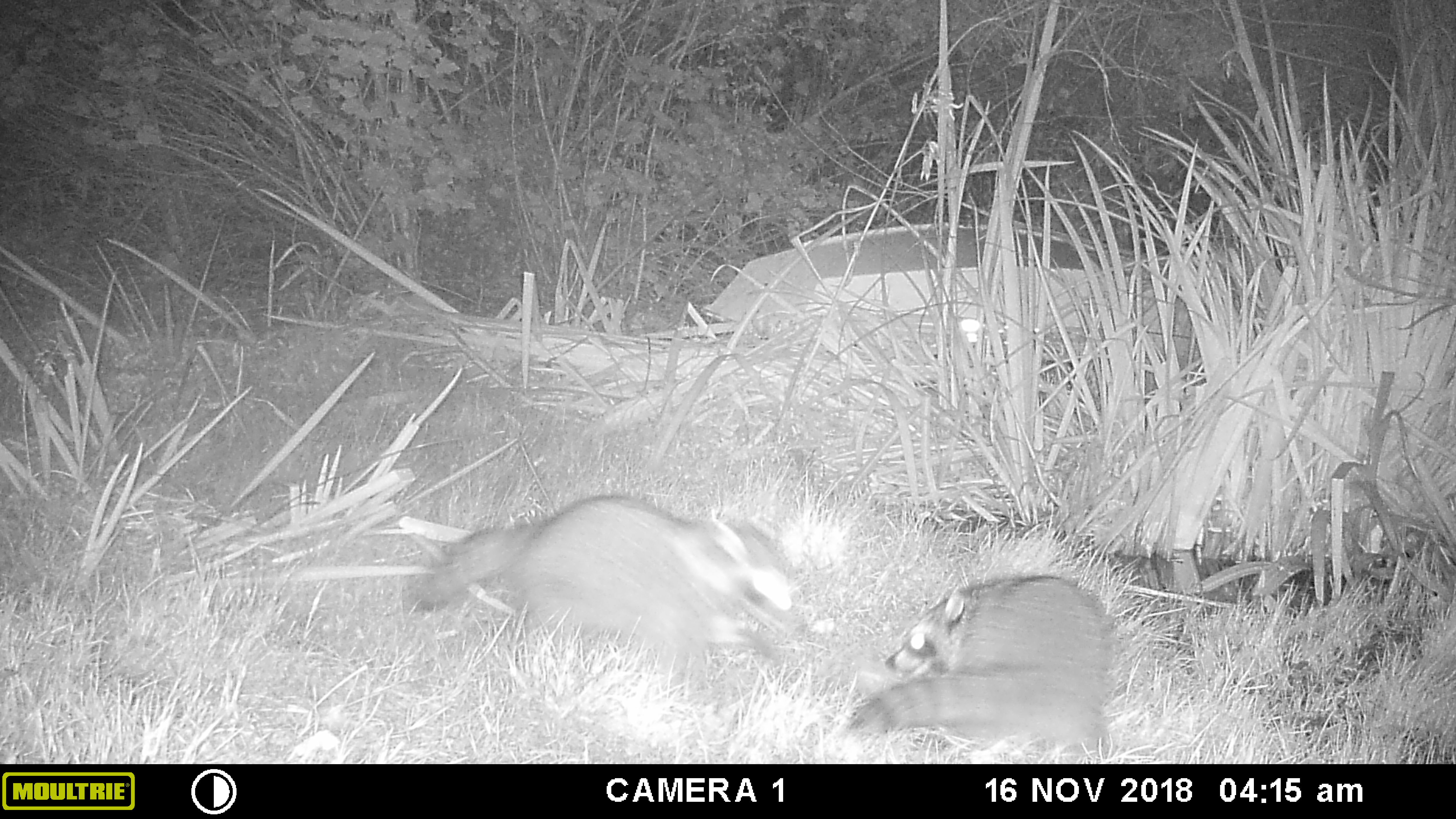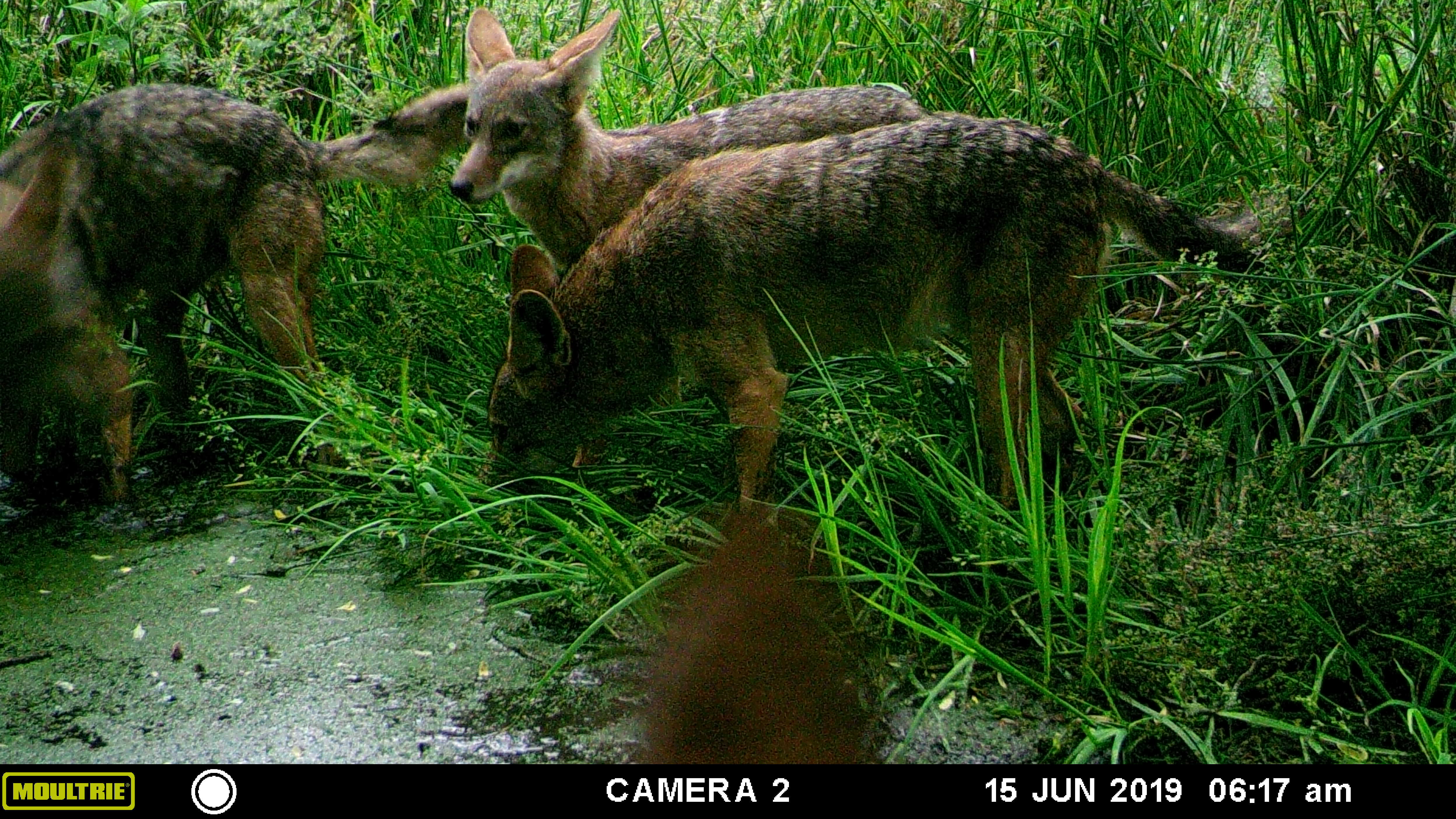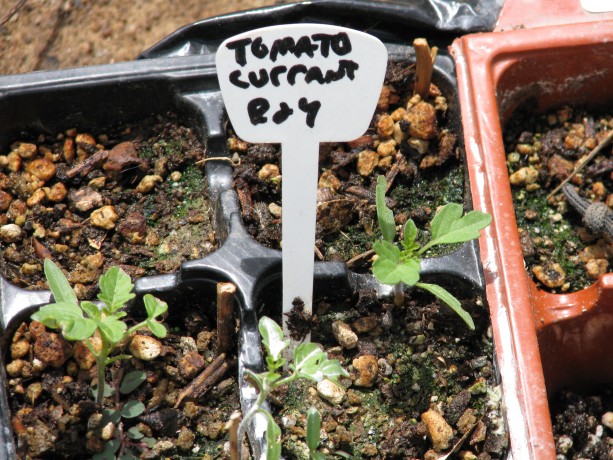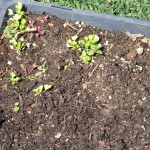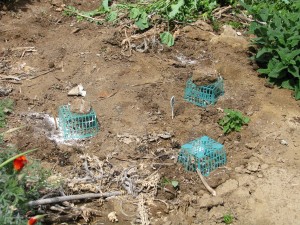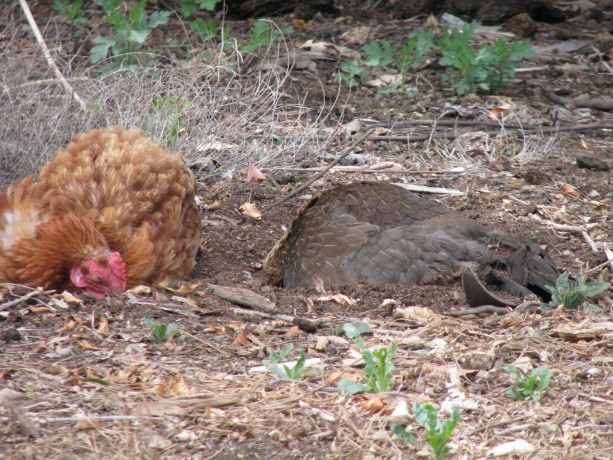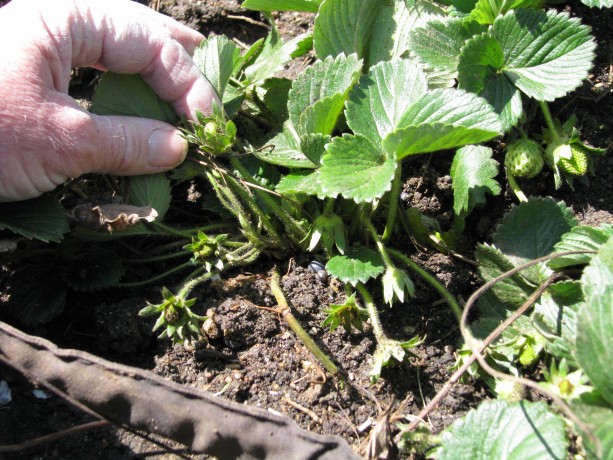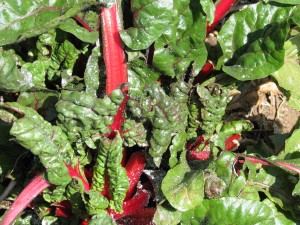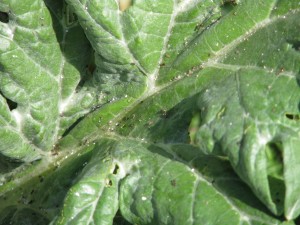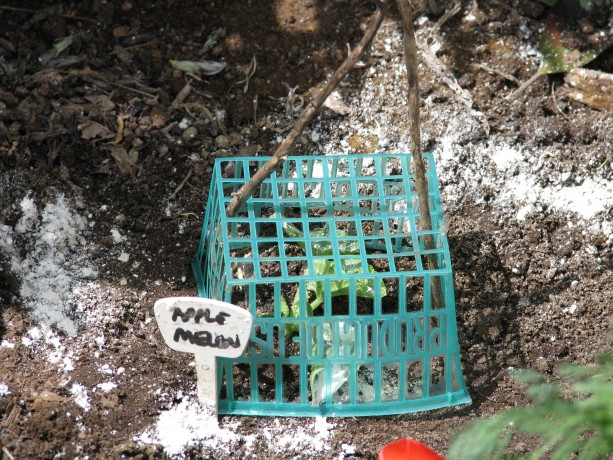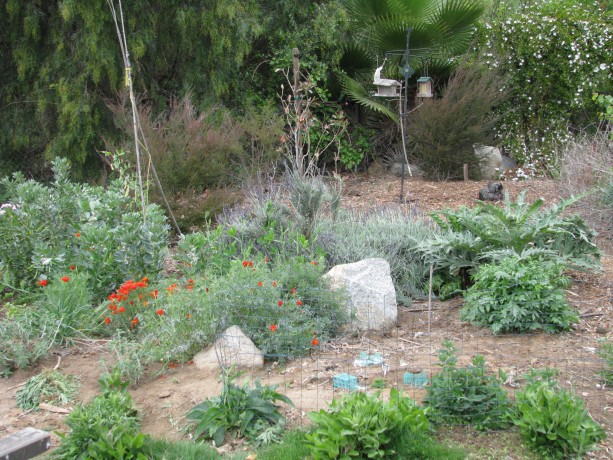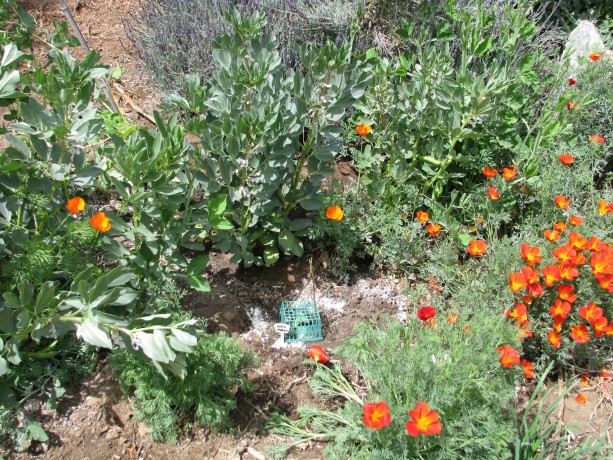- Animals, Bees, Birding, Gardening adventures, Heirloom Plants, Other Insects, Permaculture and Edible Forest Gardening Adventures, Quail, Seeds
Growing Birdseed: Love Lies Bleeding Amaranth
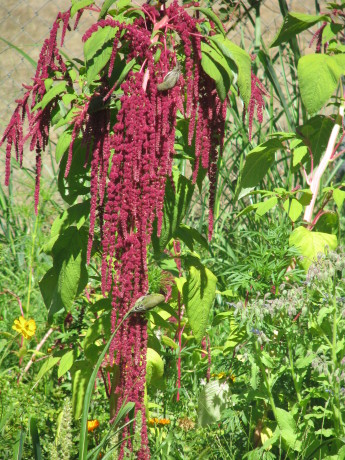
Love-Lies-Bleeding amaranth is a dramatic addition to your garden… ask a bird! We’ve participated in Cornell University’s winter Project Feederwatch for about six years. It is a volunteer amateur scientist-type program where, from November through March, you fill bird feeders and two days a week count how many birds come. Then you report your results on an online form. This helps trace changes in migration patterns and in habitats in wild birds, as well as sitings of diseased birds.
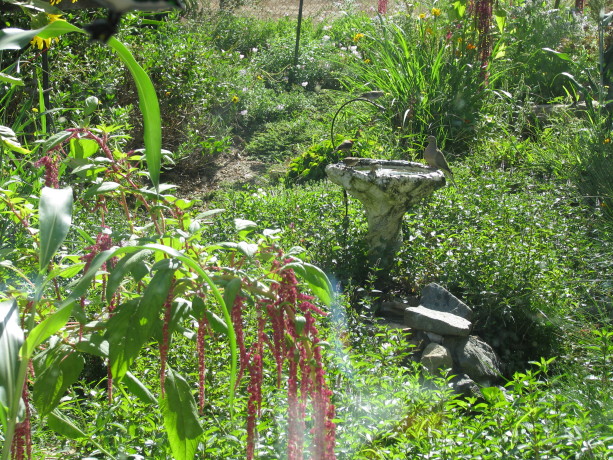
The sound of dripping water attracts birds more than food does… from long distances, too. This year I found out that most birdseed is contaminated by insecticide; some brands are reported to have illegal levels of pesticides in them. Geez! How am I going to get around that problem? I’m not sure about this winter, but I’m going to grow more of my own birdseed. In the past we’ve rolled pine cones in peanut butter and hung them out for woodpeckers and many other birds. I’ve also grown sunflowers, for both their seeds and for their leaves, which lesser goldfinches just love to eat! This year I planted heirloom Love Lies Bleeding Amaranth (Amaranthus caudatus) to some pretty spectacular results. Yes, this is one of the types of amaranth that produces an edible seed for humans; the leaves are edible as well. It can grow 3 -6 feet, with long ruby-red falls of seed heads that the birds just love.
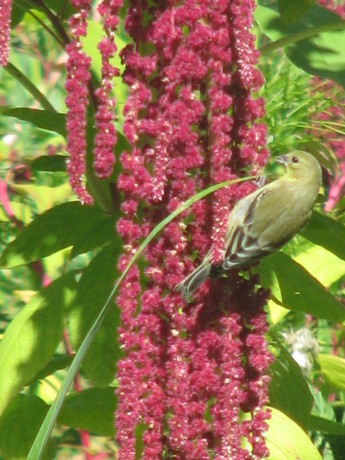
One of our Finch Frolic Finches feeding! There are many other amaranths to grow for both your own consumption as well as for the birds. Sometimes you grow it for yourself and end up feeding the birds! Of course there are many plants which attract hummingbirds all year, especially those with tubular flowers. Why do you want to attract birds? Besides their right to habitat, and their appeal to our better selves, all native animals play important roles in the preditor/prey relationship in a healthy garden. The birds may eat some of your produce, but they are also eating large amounts of bugs. They are also pooping, and you know how valuable poop is to any garden! If you plant a bird garden away from your vegetable crops, then plant your veg crops using the polyculture method, you will have birds and food for yourself as well. Please, please don’t put up those dangerous tree nets! They tear apart your trees when you try to remove them, they don’t really work, and birds can be stuck in them. When they are on the ground snakes are trapped in them! No plastic netting. Ever. Please!
Try planting some amaranth – especially this one with the dramatic name and dramatic fall of color – next spring when you plant a bird garden. Or in your edible forest garden and plant guilds. Or between your fruit trees, or along the back of your flower beds. Take a nibble for yourself if the birds will let you!
- Animals, Bees, Chickens, Health, Natural cleaners, Other Insects, Permaculture and Edible Forest Gardening Adventures, Pets, Quail, Worms
DE for Birds, and More About Chickens
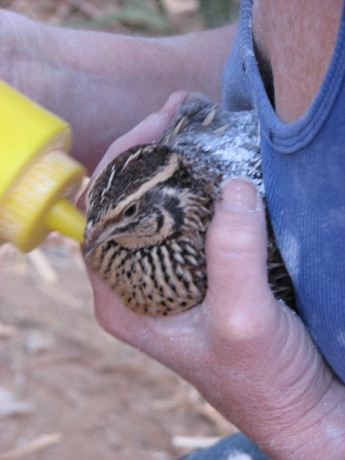
A little mustard with your quail? Cleopatra being treated. I’ve written about using Food Grade Diatomaceous Earth around plants to keep down ants and other sectioned insects. It is also used around the feet of my bee hives; as long as it isn’t where bees and other beneficials go it won’t hurt them because it has to be on the bug to work. I’ve also used FGDE around my cat’s bedding to kill hatching flea eggs, and have rubbed it into their fur. It is scentless, edible (will help kill interior parasites when eaten), tasteless, and the food grade is so fine that it won’t hurt your lungs if you breathe it in, although if you have lung conditions you should wear a mask. More about FGDE in a minute.
Some of our laying hens have difficulty laying eggs recently. Chickpea we found panting on the ground in a wet spot, with ants on her. She had a soft-shelled egg break inside of her.

Madge in the house cage, recooperating. Madge, our partially blind RIR passed a soft shelled egg, then was ill for a day when she passed a broken shell. Warm Epsom salts baths and time spent in the house cage with a heating pad helped both of them. Because of the threat of infection I used some of the Cephalexin left over from our dog (divided into small doses) on both of them and they recovered. My daughter finally deduced that in the mornings when the pullets and hens were released the big girls ran over to eat the chick mash. It probably tastes better than the lay pellets, and more importantly in their little brains it kept the pullets from eating it. Even with the supplemental oyster shell the big girls were probably not getting the calcium and other nutrition their bodies needed to make good eggs. It was time to switch the small girls to lay mash anyway, so I did and yesterday we had all four of our laying hens lay eggs… first time in a long time!
While we were bathing Madge in the sink for her illness, my daughter noticed mites on her. Now a few mites are usual on everyone and everything. When you can see several on the skin when you blow on the feathers, then you have a problem. She wasn’t having a problem, but at that time we still didn’t know what was wrong with her. After she was better we instituted FGDE Day in the Fowl Fortress.
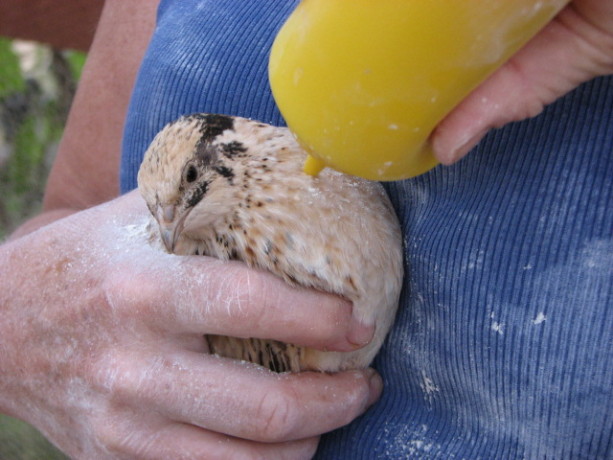
Miss Lemon, one of three coturnix hens, is treated with FGDE. You can buy pricey powder dispensers, which usually clog. I bought a set of mustard and ketchup dispensers for less than two dollars and they work just fine. We caught all the hens and our three quail and puffed FGDE into their feathers and, of course, all over ourselves.
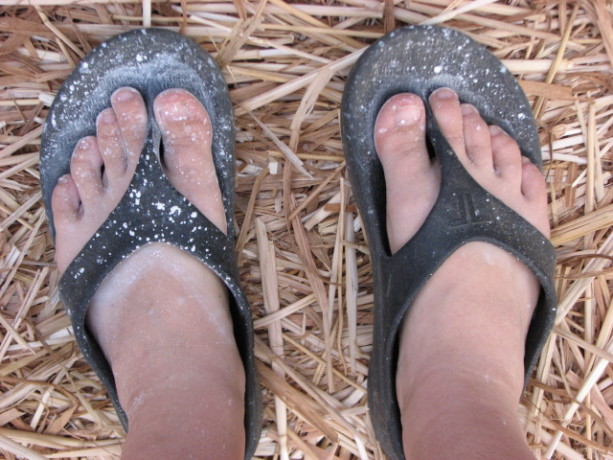
We treat ourselves, too. I puffed it into the nesting boxes, and into the ‘attic’ of the pullet house where they roost, and into the straw in the coops. Since we don’t have a problem we don’t need to treat often, just every few months or so. Any that they eat helps with any internal parasites as well. We also had some wood ash left over from making pizzas in Harry Mud the cob oven and sprinkled them where the birds take dust baths. That fine ash helps to keep their feathers clean and keep away mites too.
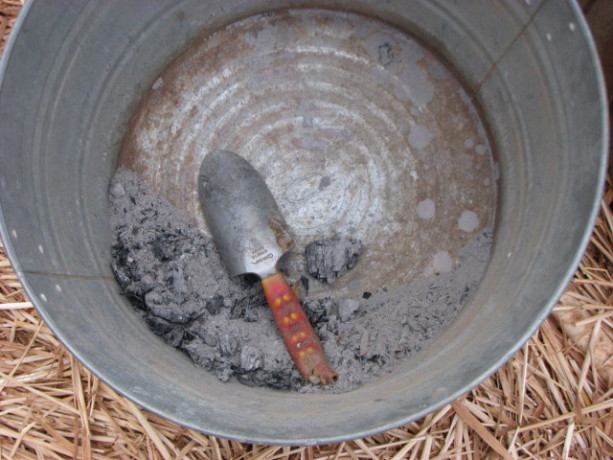
Wood ashes are good for dust baths. Very little went a long way, so even after treating all the hens and the Fowl Fortress, the cat bedding repeatedly, several cats, the feet of the bee hives, a variety of plants, and the feet of the food tables I’d set up for a garden party to protect from ants, along my window sills and around the privy where ants were getting in, I’m still working on the first bag that I bought on Amazon.com.
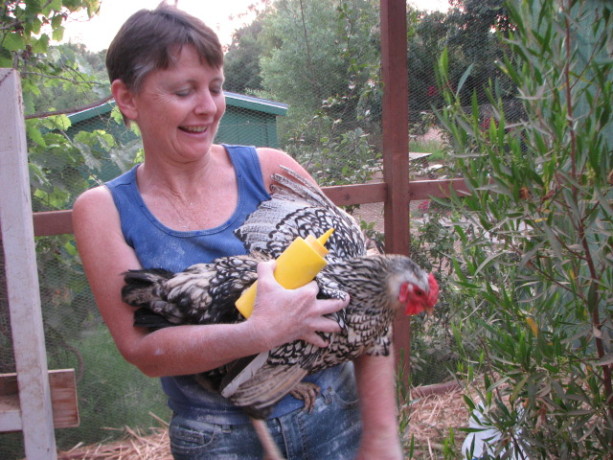
Amelia objecting to her dusting. When you compare with buying expensive different poisons for all of these problems, the health hazards and impact on non-target species including ourselves, and the negative impact on the Earth, one bag of FGDE is such a deal that you really can’t not try it.
-
Why Is July So Busy?
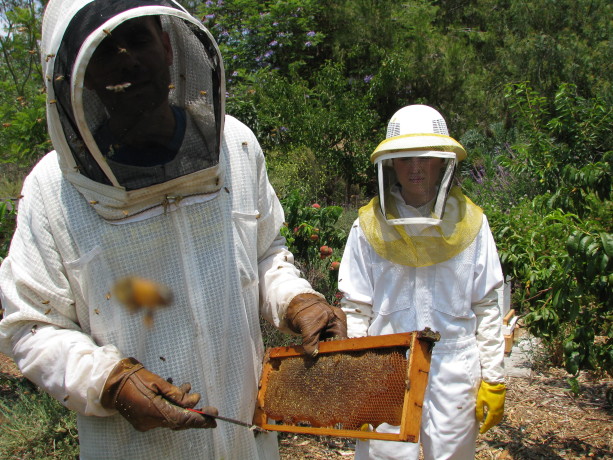
Quentin holds a frame full of wax-capped honey cells while Miranda looks on. Whew! What an early hot spell, and what a lot of things to do! The daylight is longer but animals, plants and people have a way of filling it all up. It is almost 9 pm again and still no dinner for humans this night. It is cooking. We’ve had a sick kitty, Maow, who we had to put to sleep due to kidney failure yesterday, and our ancient dog Sophie keeps us busy nursing her. She refuses dog food and only will eat veggie sausage and eggs, but none of our hens are laying in this hot weather. One of our chickens, Chickpea, had an egg break inside of her and had to have an Epsom salts warm sink bath which worked its chicken magic and pulled her through. Tonight our partially blind Rhode Island Red, Madge, has been acting funny so into the sink she went. The hens all like the warm bath so much that we don’t have to hold them down.
The garden produce has been good and keeping up with ripening fruit while beating the birds to it has been my newly graduated collegiate daughter’s role. Irrigation difficulties have created large problems, however, and lots of seeds never germinated, and several crops have shrivelled due to irregular or not enough water, while some others were drowning because of holes in the lines. Minerals from our hard water have clogged up holes in the lines, and running vinegar through the system seems to dissolve the calcium pretty well. If only it repelled the gophers who occasionally nip the underground lines, or the weeding tools that unerringly nick them.

Quentin and Miranda with one of the new hives of Italian bees put up two months ago. We have two co-op bee hives, set in place by Quentin Alexander of BeehiveSavers.com. He performs humane bee removal, and also has the co-op program where he sets up hives in your yard with calm Italian bees. You pay for the equipment, and he monitors the hive for a year to study the bees and see what is affecting the disappearance of European honeybees. He harvests the honey and gives you half of it, too. This is a perfect set-up for me since I just don’t have the time to deal with the bees anymore, and because I swell up when stung now. We had a swarm in a stack of empty bee boxes next to our trashcans for a couple of years and they never gave us any trouble, but I wanted to move them to the Bee Garden.

Quentin beginning to move a two-year hive that had settled in my stack of supers. The bees objected. When Quentin moved them a few months ago, he found out that they were an enormous ‘hot’ hive… pretty aggressive.
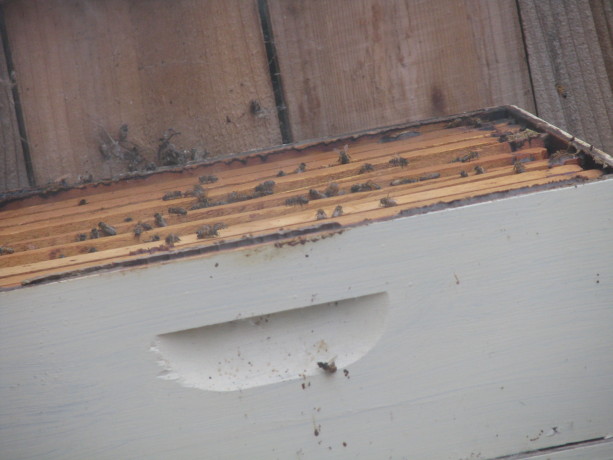
Bees complaining about having their home ripped apart… I can’t blame them. Yesterday he came with two ‘nuc’s, or ‘nucleuses’. A ‘nuc’ is a new queen bee and about a pound of workers devoted to her. With my daughter’s help, and with me hanging back with the camera, he opened the moved hive. It was breezy, humid, mid-day and in the 90’s, all bad conditions for opening a hive.
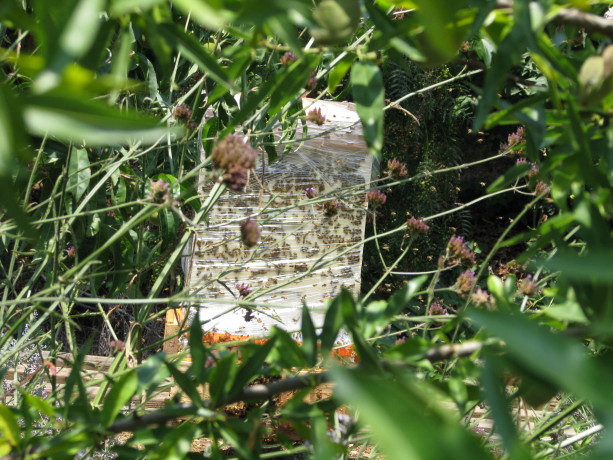
The wild hive wrapped with the ‘hot’ queen isolated in one of the supers by queen excluders. She will be replaced by a gentle queen. He looked for the old queen and couldn’t find her, so trapped her in one of the three boxes he thought she was in, moved honey and larvae over to two new boxes and set up the new queens. The idea is that the new kinder and gentler queens will breed more docile bees, and in a few weeks the whole swarm will not only have been divided into two but will have produced calm bees.
Explaining this to bees who were stressed from drought, heat, direct sunlight and humidity while tearing apart their hive, taking out brood and honey and looking to kill their queen, was a different story. A normal hive can have 60,000 bees or more in it at its peak. This was a larger hive. The bees decided that Quentin – and anyone else in the area – were going down with them. I don’t blame them. Attack my family and I’d come after you, too. Quentin’s gloves were studded brown with a forest of stingers. The neighbor called asking about bees because his gardeners were stung.
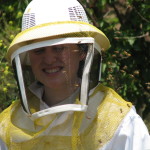
Miranda surrounded by very angry bees. No stings penetrated her bee suit, but on a humid day in the mid-90’s that suit sure was hot. We had to walk the property, roll in some jasmine to mask the ‘anger’ pheramone with which our bee suits were covered, and dash into the house. Quentin drove off in his suit with bees in his car – not an unusual sight for a beekeeper, but with the BeeHiveSavers logo on the side it looked very appropriate. We had to stay in the house until dusk when the bees went to bed (they don’t fly at night). Today the rest of the property was back to normal, but we did stay away from the Bee Garden for several more days. There are peaches to harvest in there, too, but we’ll have to donate some to the birds.
- Bees, Gardening adventures, Other Insects, Permaculture and Edible Forest Gardening Adventures, Seeds, Soil
Hairy Vetch
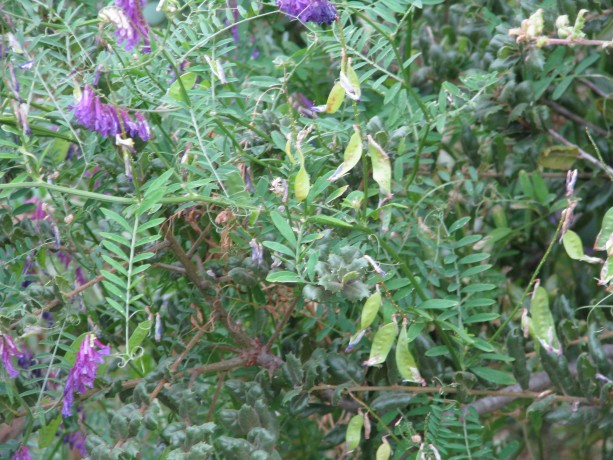
Attractive flowers and seeds. Hairy vetch (Vicia villosa), also known as winter vetch is a nitrogen-fixing plant that is used mostly for cover-cropping in monoculture fields. Native to Europe and Asia, it is a winter plant sown in the Fall and, in places where it snows, is killed off with the cold or tilled into fields. When a nitrogen-fixing plant dies or is cut back, roots die and release the nitrogen nodules into the soil. Here is sunny San Diego the vetch thrived since I sowed it in Spring of last year. It is a pretty, vining plant, with lovely dark purple blooms that bees and other pollinators love. It produces pea pods like its edible relative the fava bean, but I wouldn’t eat them. The seeds may be bad browse for livestock as well. The roots help hold soil during winter rains, too.
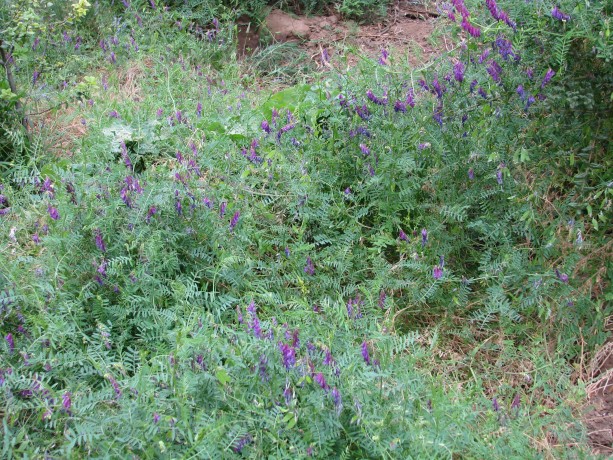
Hairy vetch clamboring all over the place Vetch can be hard to get rid of because it reseeds easily. It will also climb up bushes, competing with the bush for sunlight. If I didn’t know about the nitrogen-fixing properties and if the bees didn’t like it so much, I’d suspect it of being an invasive.
To control it I take my trusty hand scythe and cut the vetch out of bushes and close to the ground. I leave the vines to decompose and protect seedlings that I plant to take advantage of the newly-enriched soil.
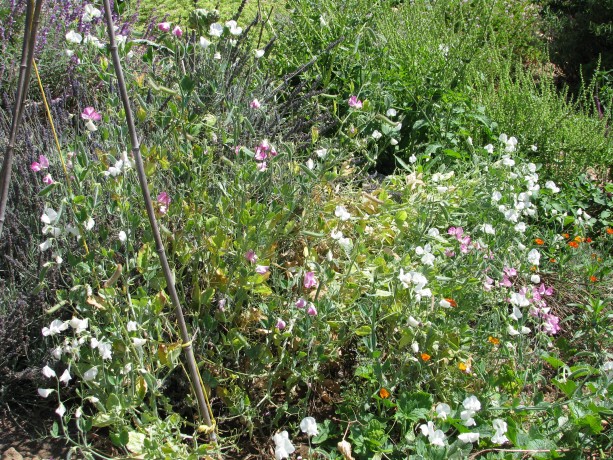
A mass of sweet peas climbing a lavendar. If you don’t want a cover crop that is so aggressive I suggest sowing a mixture of lupine, sweet peas, edible peas and fava beans in the Fall here in Southern California, and again in early Spring. In cold areas check with your farm advisor on when to plant.
-
Fruit Tree Guilds: Making Your Trees Healthy and Happy
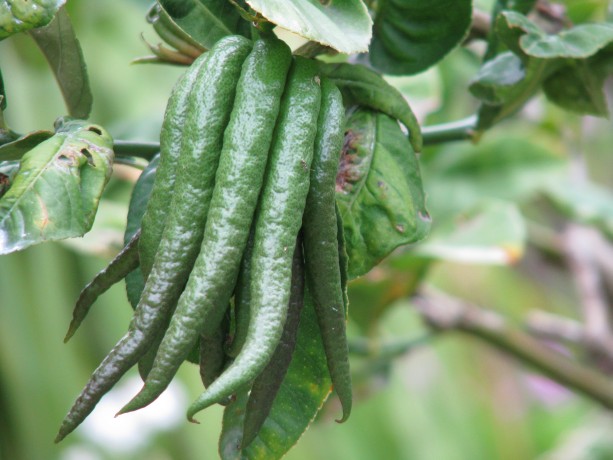
An unripe Buddha’s Hand citron. When bright yellow it freshens a room with a citrusy floral fragrance; is zest is wonderful in cooking and it can be candied. Or simply stuck up a sleeve and used to frighten people. A guild in permaculture terms is, as you know, an arrangement of symbiotic plants that serve as a plant community for the benefit of the whole. Visitors to Finch Frolic Garden often remark that planting guilds sounds so difficult; that they’d need to study so much about plants that it would be impossible for them to do. Not so. However, it isn’t just a whole bunch of plants planted so that they are stepping on each other’s shoes. The typical permaculture plant guild is defined by plants which do these functions: an upper canopy tree (shade, mulch from falling leaves, deep tap roots, roosting for birds which poop, hunt, etc., traps humidity, catches and filters rain and fog moisture), a lower canopy tree (same functions but shorter), a ground cover (habitat for small hunters and moisture trap), a miner plant (deep tap root to bring nutrients from deep in the soil to its leaves which deliver said nutrients when they decompose, and tap root breaks up soil and gives passage for water and worms), a nitrogen-fixing plant (works symbiotically with bacteria to trap nitrogen from the atmosphere on root nodules, which release into the soil when the top dies), and a pollinator-attractor (flowers for bees and all the tiny native bees, wasps and flies).
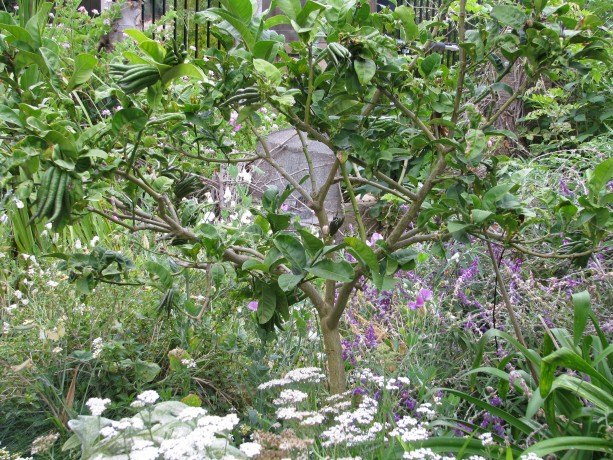
Buddha’s Hand citron (Citrus medica) happy in a guild of yarrow, sweet peas, artichoke (the leaves of which are regularly slashed and dropped), Cleveland sage, scented geranium and a variety of bulbs. The formula isn’t that complicated. I challenge you to come up with an example of each right now. Yes, you can do it. (Dum dee dum… I’m waiting for you to be done before I move on. ) Have it? Okay, here’s a quick example. Mulberry, dwarf peach, strawberries, carrots, sweet peas, dwarf yarrow and fava beans. The canopy trees will lose their leaves allowing sun to warm the understory plants in the winter. Strawberries make an excellent ground cover that grows food and loves the fungus-rich loam made by decomposing leaves. Carrots like cool weather and will thrive until ready to be pulled (and tops broken off and thrown on the ground) about when the trees fully leaf out. Sweet peas attract insects, smell great, and as a bonus are nitrogen fixers, and can twine up the tree trunks. Dwarf yarrow helps choke out grass, is used for many purposes including as a dye plant, and its flowers are clusters of small flowers perfect for the tiny pollinators, and bush peas are completely edible and also fix nitrogen. See? Easy.
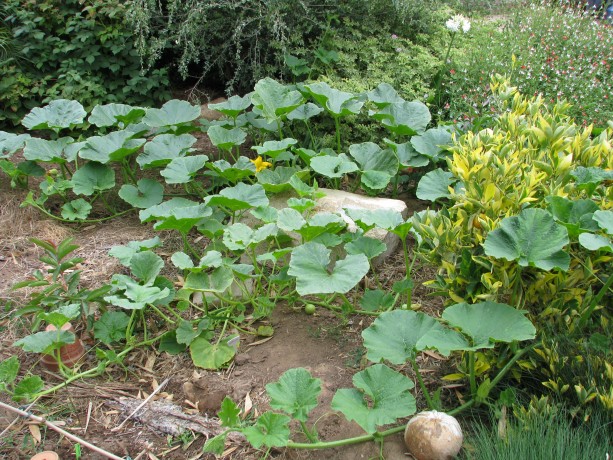
Just in time for summer’s heat, a kabocha squash is rapidly covering the ground around the variegated dwarf orange and a young pink guava. I have to pull squash out of trees because they think they own the world, and it hurts to hit your head on a dangling pumpkin. I leave the vines to decompose in place after harvest. I have many, many trees which were all planted at the same time, and some of them have been neglected. A combination apple tree had been planted in extremely heavy clay and it hasn’t grown much in two years although it keeps trying to produce fruit. Bermuda grass (I cross myself when I mention it) has infiltrated the area to about four inches down. It is helping to break up the clay, but it is also choking out everything else. Plant guild time.

Bermuda grass in heavy clay right next to the trunk: no good. Last weekend I spent about three hours in the morning (mercifully before the June gloom dissipated so I didn’t roast in the heat) digging up and pulling out as much Bermuda grass as I could from the clay. I’d even soaked the area well the night before. That was the stuff of cob ovens. When I’d finally cleared past the tree (I’ll continue another day; there’s only so much of that my hands can take!), I shoveled in some pigeon guano that my good friends up the street deliver to me (tied with a ribbon! Christmas comes all year for a gardener!). The guano is very high in urea… you can smell the ammonia, but it also has feathers, corn and pigeon peas in it. Pigeon peas are a perennial legume that set nitrogen and produce wonderful pea pods for stir-fry. I watered it in well.
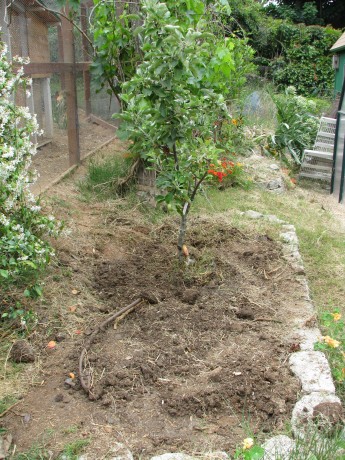
This apple was planted in clay in this planter. Never create a planter around an existing tree; mulch around the trunk will kill it. I had purchased some plants for the area, but to keep costs down just chose some that would fill out and help choke out the angry Bermuda grass bits yearning for revenge. Also, the tree is close by Harry Mud, the cob oven, so I wanted pizza-themed plants for easy picking. I planted strawberries right by the trunk inside the gopher cage in which the tree is planted. They will help retain moisture without compromising the bark of the tree. You never want to pile mulch up around the base of a tree above the root ball because you will rot your tree.
I also planted a tomato, a perennial basil, garlic chives all around the edge (bug protection), sunflowers, a prostrate rosemary and French tarragon. The pigeon peas and corn will very likely sprout. What I didn’t have was an upper canopy, but the tree is on the east side of a shed which protects it from the worst of the summer afternoon sun, and there is a grapevine nearby which produces leaf litter. When daffodil bulbs are readily available in the late Fall I’ll plant a ring of them around the drip line. Gophers don’t eat them, they help keep away the grass, they break up the soil and they are one of my favorite flowers (ranking second to sweet violets). All these plants as they grow up, down and across will help the apple tree, and the apple tree will help them. All of them produce food within easy reach of the cob oven and outdoor dining, are attractive and smell good, too. The tree should flourish. I don’t kid myself that I won’t be pulling Bermuda grass in the future, but the plants will help control it by shading and crowding out.
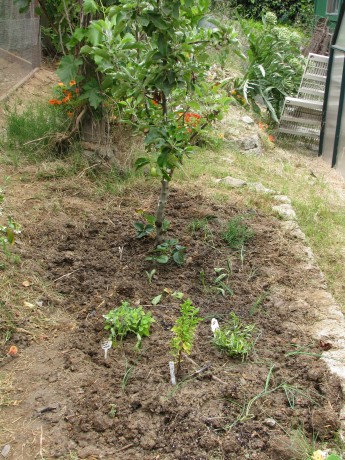
It doesn’t look like much now, but there are eleven support plants/seeds to help the apple tree now. Friends! If you have citrus trees you should plan a little differently. When trying to understand a plant, think of where it came from and in what growing conditions it thrived. Avocados are from South America, with humidity, rainfall, protection from intense heat, deep leaf litter and adequate drainage. Stonefruit are from areas with cold winters; their leaf drop keeps the roots protected from the freezing that triggers the trees to set fruit (chill factor).

This citrus was planted before the bamboo grew up to shade it. Notice how the leaves grow straight up, and none below? It is aiming to collect light at noon, which is the only direct sun that it receives. He needs to be moved. We think of citrus trees perfuming the air of Spain, Greece or Arabia, but actually they come from Southeast Asia and before that, New Guinea and Australia. All of these places have warm or hot temperatures and plenty of sunlight. Although you can plant stonefruit close together, for citrus it is best to ensure that the trees receive lots of direct sunlight or they will drop leaves and have stunted growth.
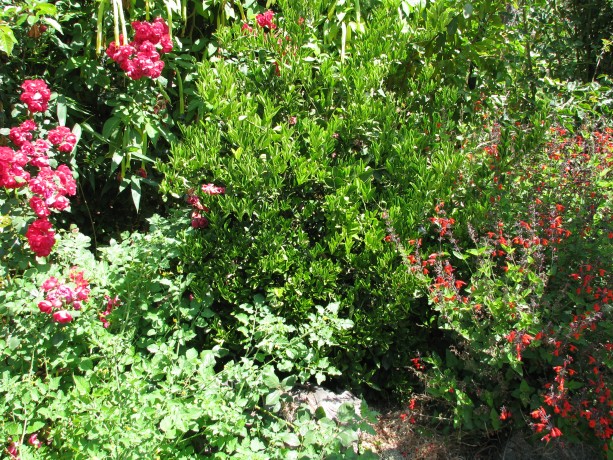
This citrus receives sun all day, and is very happy with the tomato, roses and sage that surround it. Raking all the leaves out from under your trees is so wrong. The tree drops leaves because it needs them on the ground around its roots, not because its careless or its waiting for a human to come by and clean up its mess. Leaf mulch makes the ideal conditions for microbial growth and perfect soil, so let it sit. Augment the mulch by giving your tree company of other plants. Unless the tree is allelopathic (secretes a substance that keeps anything from rooting nearby so that it doesn’t like competition, such as walnuts and eucalyptus) then in nature it reseeds close by and allows other plants to grow under it. Give your trees some appropriate company, and you’ll be rewarded with lots of food, medicine, habitat and very little work except for harvesting. Can’t beat that with a stick.
-
New Bog
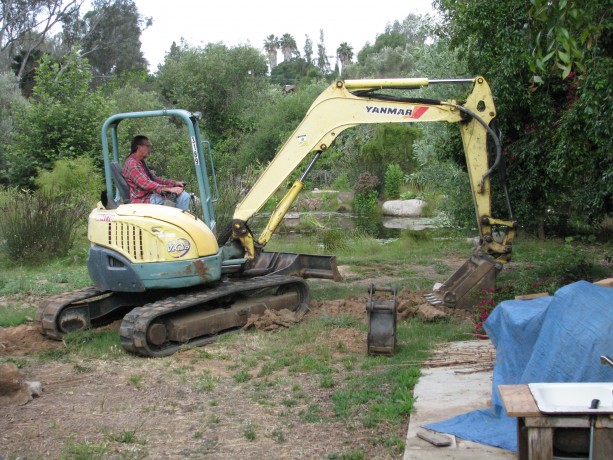
Steve demostrating years of expertise by finessing this large piece of equipment. Last week a new bog area was added to the main pond. The first bog area was dug by hand, created so that there would be a shallow, flat habitat for wading birds and tadpoles.
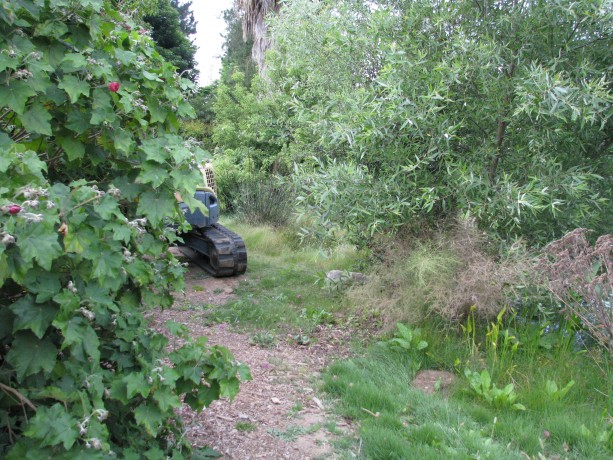
Preparing to start. This is called adding edge, which is an important component of any permaculture design. The first bog is connected to the series of rain catchment basins and now is the link between rain overflow system and the large pond. This year no rainwater left the property; it was all captured. Edge areas in both water and plant design provide more sun and growth areas than a round or straight design. More interesting things happen on the edge.
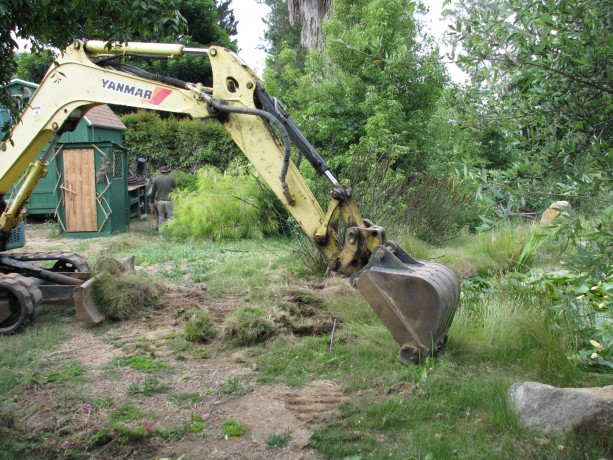
Gentle scraping with the bucket to discover where the subterranean irrigation lines were without stretching them. This bog area was dug up by a tractor bought from a farm auction that I’d shared rental with a friend. It took a large mound of dirt and filled in some dips, leveling a walking and working area.
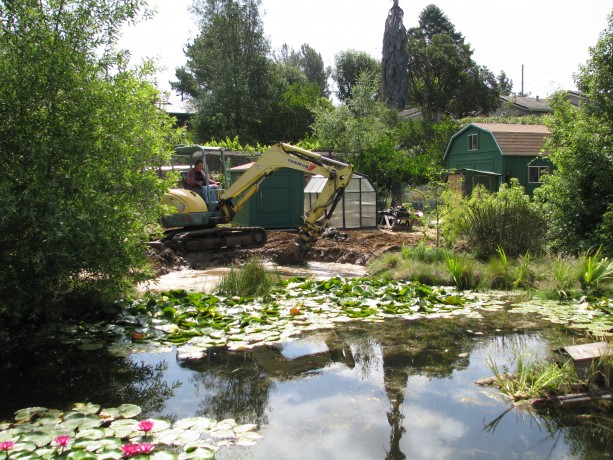
Another, cross-pond view of the new bog. Steve, who among his many talents is also a heavy equipment operator, did a terrific job grading and then expanding the pond. A small problem is that he found some more porous soil with the clay, so the water level on the pond dropped.
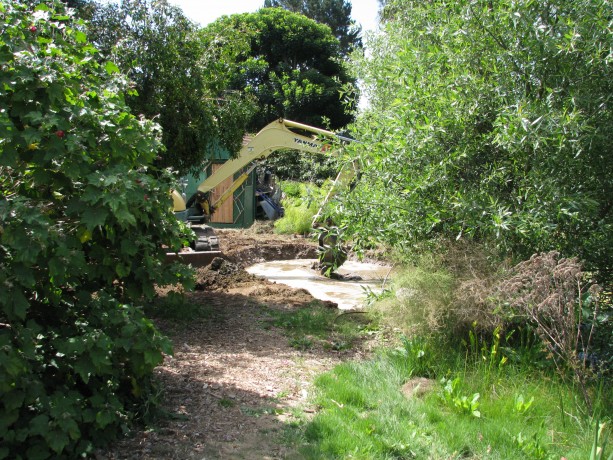
Water is filling in. We’re seeing how far it goes down to tell if the seepage is occurring on the edge or on the bottom of the new area. Once found, we’ll move extra clay over and tamp it all in.
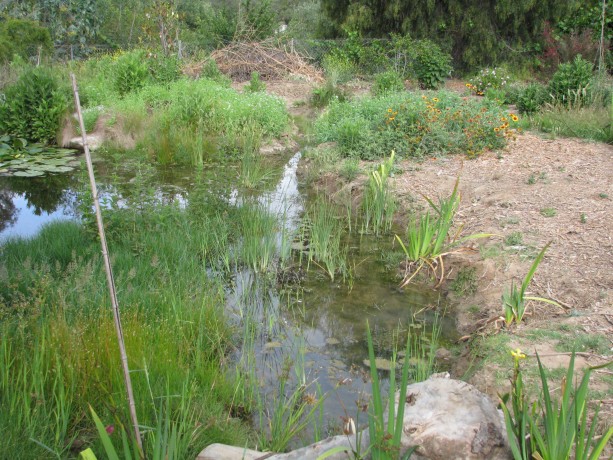
The first, hand-dug bog now filling with plants. Plants Jacob has put into the first bog include graceful cattails, which are a dwarf cattail that isn’t so invasive, iris, rushes, watercress, and some Mexican waterlily.

Sophie admiring the first bog. Very soon the plants will cover the bog areas providing excellent cover for many animal species which… wait for it… live on the edge.
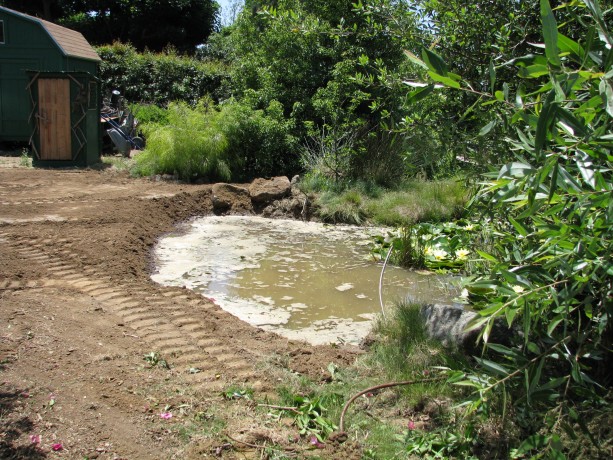
Waiting to see how it sealed and then ready for planting. - Animals, Chickens, Permaculture and Edible Forest Gardening Adventures, Pets, Quail, Seeds, Vegetables
Updates on Crate Potatoes, Nursery Plants and Chicks
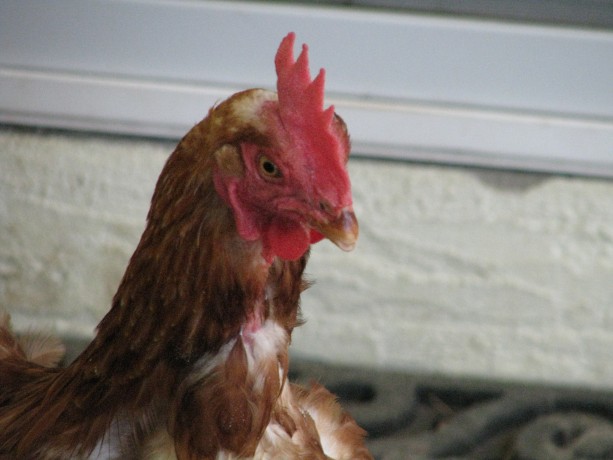
“Whaaa…???” Spring has brought its fervor of growth, of veggies, babies and weeds. Between my bouts of sneezing from pollen (great thing for a gardener to have!), and while the day is very warm outside, I thought I’d update you on how things are going.
A couple of weeks ago I posted about growing potatoes in milk crates. Success so far. The potatoes are growing quickly and coming through the second layer of crates.
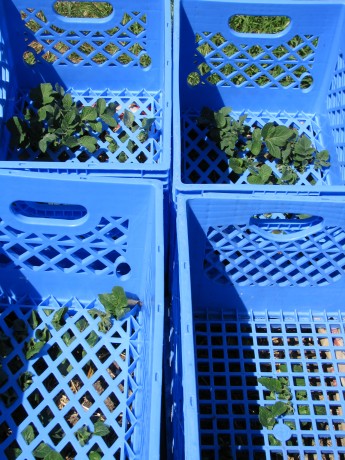
Potato greens emerging through the second layer of crates. I need to backfill with more compost. The potatoes planted in the raised beds have been hilled up as much as the sides will allow. If I am ambitious, I may find some long pieces of cardboard to raise the sides higher, and fill some more.
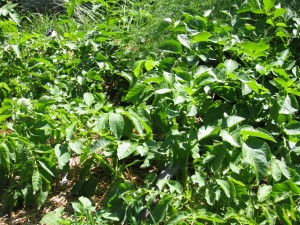
More potatoes! Potato greed!
My nursery bed is mostly ready for transplant out into the larger garden.
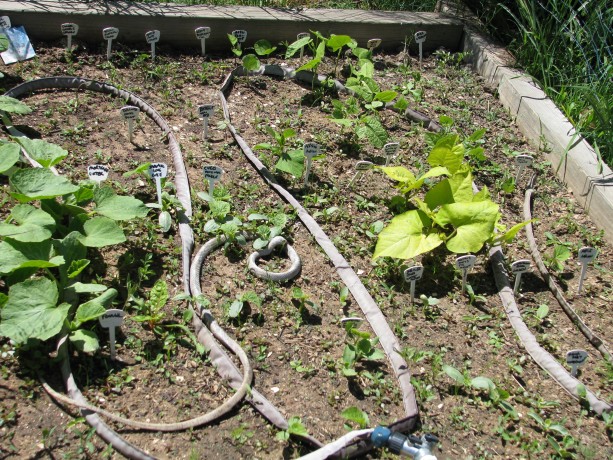
Yes, the rubber snake keeps the birds away. I need more berry baskets to help keep them safe, and I need to build support systems right away for tomatoes and other crops I want to keep off the ground.
The chicks are about a month old. They’ve been living in the downstairs bathtub with heat lamps. There are only seven chicks now. We purchased the eleven on a Wednesday afternoon. By the next evening four were ill. All four died during the night, even after my daughter and I kept them warm and full of antibiotic/vitamin water. We don’t know what happened to them, but at least it wasn’t something that took the whole flock. There are always casualties with day-old chicks. They are shipped in the mail straight out of the egg, with a variety of temperatures, food and terrors. When purchasing a large amount of chicks straight from the hatchery, you’ll often receive extra chicks to ‘make up’ for those that perish. Our chicks that died were both light Brahmas, Annabelle Lee and Daisy, Ruby, one of the Rhode Island Reds, and Hermionie, one of the Americaunas. The rest are growing just fine, although I noticed today that Belle, the remaining Americauna had come to some injury within the last week.
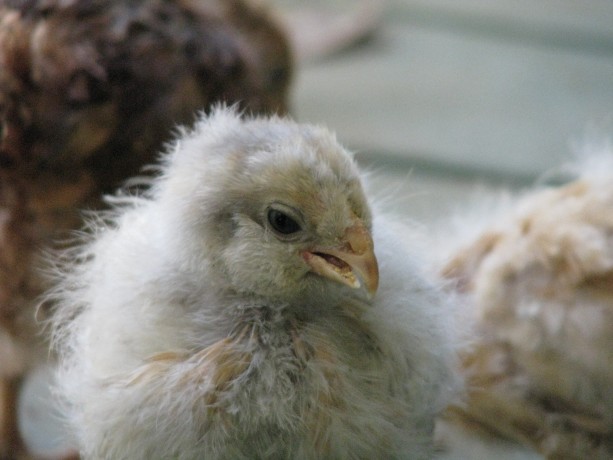
“I’m Belle, the Americauna, and I’m beautiful even with a dislocated jaw.” Her lower beak is crooked and jutted forward, doubtless an injury caused by flinging herself around in the bathtub with the rest of the girls. She is eating well and seems to be aggressive, and there wasn’t anything I could do to the beak with my fingers through massage or gentle manipulation, so I think she’ll have to see it through. UPDATE: my daughter says that she might have ‘crossbill’, which is a genetic condition that gradually shows up. Not much to do about it; some hens thrive and some can’t.
There is always the chance that some of the remaining seven, especially the straight-run cochins, are males, and they will have to find other homes. I’m really hoping for all hens.
Today I not only took the girls out of the bathtub for the first time on a field trip to the warm and safe back porch, but also introduced them to Viola the House Chicken.
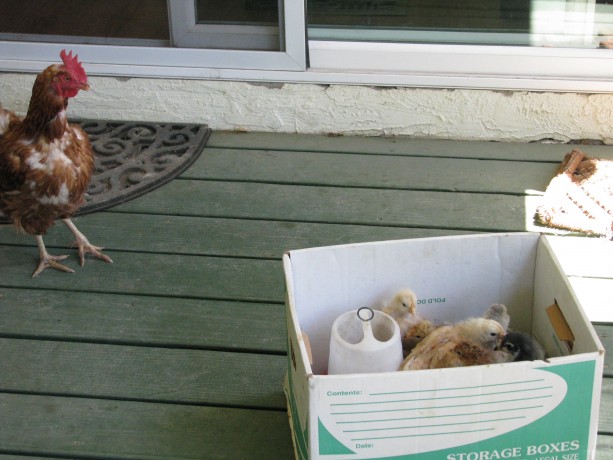
“What the heck are those?” Viola stays in the front yard all day alone, and then comes into the house to her cage at night. She’ll lay in the dog house on the porch where Homer, our lost desert tortoise used to sleep. The chicks are flighty, both in personality and in how they are trying to exercise their wings by sudden wild bursts of flapping that take them off their feet: a surprise to all including themselves. They discovered sunshine, leaf bits, perching,
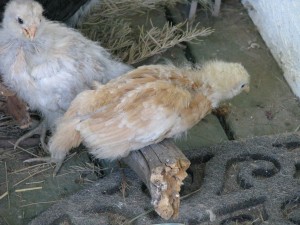
I can perch! and that Viola was absolutely afraid of them. Viola did all she could to get back into the house through the screen while complaining horribly.
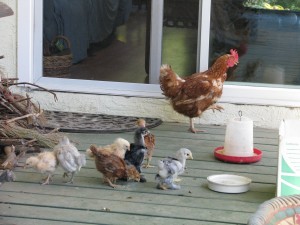
“Get me away! I’m going through the screen if I have to!” I realized that she needed to lay and the chicks were blocking her entrance to the doghouse. I let her in and barricaded the pathway and she settled in whirring grumpily to herself.
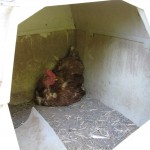
“Can’t you see I’m doing serious stuff here?” Just now I heard her complaining at the top of her lungs to find that the chicks had visited her, and one bold one in particular, aptly named Bodacea, was standing next to her either inquisitively or in horror. I seperated them and they all calmed down.

“I’m Mulan, a black chochin, and I have feet feathers and a cute butt.” 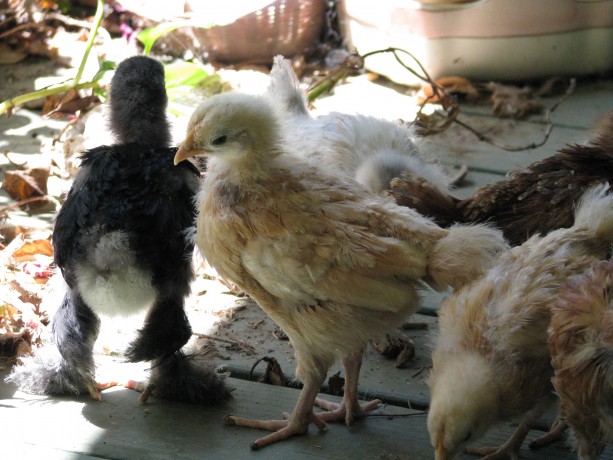
“I’m either Esther or Myrtle, a buff orpington, and she does have a cute butt.” 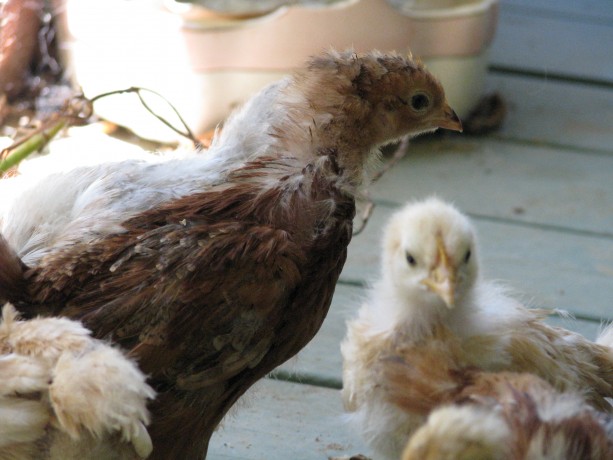
“I’m Charlotte the Rhode Island Red, and I’m going to be just like Viola some day. Without the limp.” 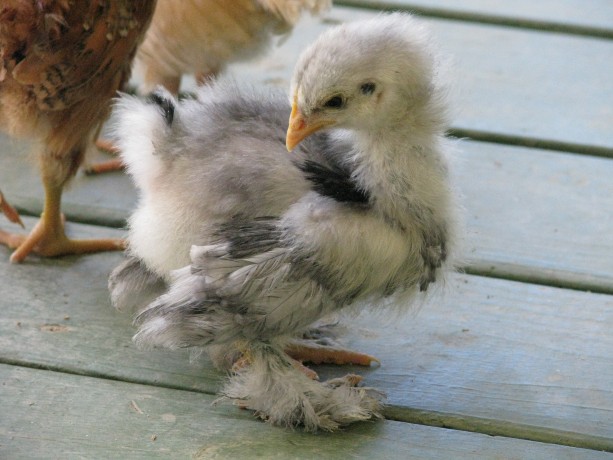
“I’m Bodacea, a blue cochin, and I have a cuter butt.” 
“I’m Malaika, and a Turken isn’t a cross between a turkey and a chicken! We were bred in Transylvania. Go figure.” 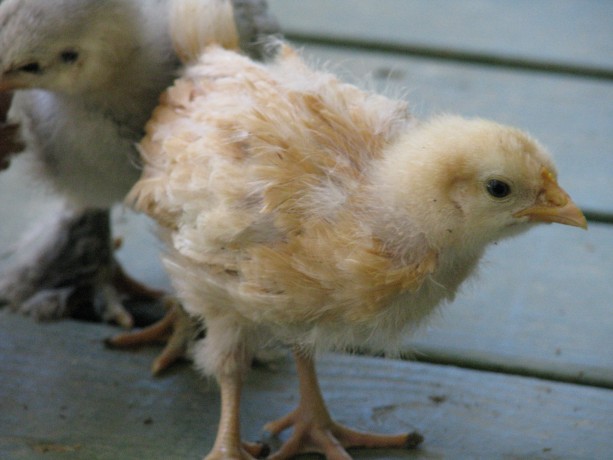
“I’m either Esther or Myrtle, the other buff orpington. The cuter one, obviously.” The nights are still cool and I still have a rat problem in the Fowl Fortress (I’ve been installing a couple of my cats in there overnight to help discourage the looting) so I’m waiting until maybe next week to introduce the girls to the rest of the flock. I’ll oust the Saki the male quail and let the girls take over his house. Its all so complicated!
- Animals, Bees, Chickens, Gardening adventures, Other Insects, Permaculture and Edible Forest Gardening Adventures, Quail, Seeds, Soil, Vegetables
Protecting the Little Guys… and a little about diatomaceous earth
When transplanting little plants out into the big garden it feels like sending your child off to their first day at Kindergarten. All kinds of things can happen to them in the big world. For children… that’s too large a topic for me (Kindergarten mother survivor here). For plants I can give you some advice.
Besides watering too much or too little, and root disturbance while transplanting, little guys can be eaten by bugs, birds or other animals, or simply get lost and overlooked. (Here is a container growing tip: as your seedlings sprout and grow, gently pass your hand across them every time you are with them. It will make for stronger stems.) (And its fun!)(And you can pretend you’re ruffling their hair and say things like, “Hi, Sonny.” Or not.)
A day before transplanting out of a container or from a nursery bed, water the sprouts well. If they’ve been in containers for awhile those roots may be going in circles and the water can’t penetrate from the top very well. If that is the case, put the pots in water for half an hour until moisture is wicked into the pot thoroughly, then allow to drain. I say to do this the day before because if you water just before planting the soil around your root ball will fall apart, breaking fine hair roots and shocking your poor little guy. Some plants hate their roots being touched so much that this would kill them. By the next day after watering the container will still be moist, but the soil should be solid enough to stick together when tipped out.
Dig a hole twice as wide and twice as deep as your plant, then backfill with a mixture of good compost and the soil from the hole. This will help acclimate the roots to the soil change. Water the hole, and if you’re really industrious water with compost tea. Set your plant into the hole and firmly press the soil around the plant. If you are planting tomatoes, eggplant or peppers (all in the same family) you can set the plant more deeply into the hole; they will form more roots from the stems and become sturdier. The rule of thumb otherwise is to plant so that the soil level of the hole is the same as that of the transplant; many plants will rot if soil is up against their stem. If it is too low, the roots will be exposed and dry out. Potatoes can be trenches and hilled up as they grow, or maybe you will try trashcan or crate potatoes. If you live in an arid area, plant in shallows so that rain can accumulate around the plant. If you live in a wet area, plant on hills so water can drain off. Or if you’re practicing permaculture, plant on the swales!
So your little guy is in the ground and gently tamped in. To keep off the birds and bunnies and mice and rats and whatever else is looking for dinner, I use plastic berry cartons turned over and set in place with sticks or with rocks on top. Reuse and repurpose! They are also good for protecting figs . The cartons allow enough sun in, and also makes it very obvious where the seedling is so that you don’t step on it, or weed the little tomatoes out with the almost identical ragweed sprouts. For larger plants, turn over a milk crate.
I have no native quail in my yard. Due to nearby houseing developments, there aren’t many quail around me anymore. Quail would fill the niche of beetle and sowbug eaters. My hens want only worms, spoiled things, and their big feet do a lot of damage if not watched.
Sowbugs cluster under mulch and do damage to stems and fruit.
I use a little food-grade diatomaceous earth around the seedlings, new sprouts in the garden, around the strawberry plants, and also around plants such as artichoke, corn and chard where ants have begun to farm aphids.
I use it around the trunks of my stonefruit trees to stop the ants, and have been told that it works well around the legs of beehives in lieu of or in combination with cups of oil to keep out the ants. Diatomaceous earth is the finely ground bodies of ancient sea creatures (diatoms). The powder on a microscopic level is full of sharp edges.
When a sectioned insect such as an ant, flea or sowbug crawls on it, it rasps their tender areas and dessicates them. Not something I really am happy about doing to the bugs. I’m only using it on a very small scale. Remember that any insecticide, even DE, kills many kinds of insects not just the targets. You don’t want to eradicate your insects; most of them are helping your plants and your soil. DE will melt into the soil when watered, but only reapply if you still see the target bugs. The problem might already be taken care of.
Use food-grade DE, not the kind that is sold in pool supply stores. FGDE is used in graineries to keep weevils and other bugs out of grain and beans, so you’ve been eating it for years without knowing it. It doesn’t hurt us, nor is it bad to breathe (some people wear masks that they can get from https://accumed.com/n95-mask-for-sale-respirator-safety-face-mask-z1.html, just in case). It is a great, natural and inexpensive way to fight fleas without paying big money for poisons to put on your pet. I have it all over my cats’ bedding.
They sell DE sprayers, but they become clogged. The easiest and least expensive applicator (which can be repurposed)? A condiment dispenser. You know, the plastic mustard and ketchup squeeze bottles in diners. I bought a set of two for $2. You can practice a little to dispense a finer dust.
So I plant my little guys, give them a drink, squeeze a little DE around them, give them a berry basket hat until they outgrow it, then take it off to use elsewhere. If there is still a threat to your plants from critters (somebody was eating my eggplant leaves last year! I mean, really…ick!), then turn a wire gopher cage over the top or make a wire cage to fit and use sticks or landscape staples to fasten into the ground.. These, too, you can reuse yearly.
- Compost, Gardening adventures, Permaculture and Edible Forest Gardening Adventures, Seeds, Soil, Vegetables
Crate Potatoes
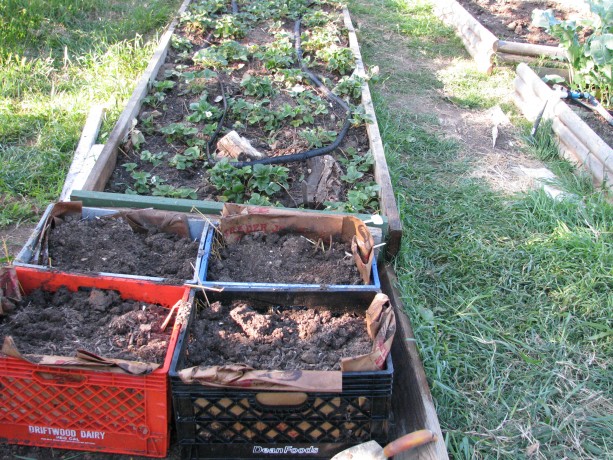
Milkcrate potatoes! This area receives sun for half a day and is shaded on the West side; perfect for keeping them cool. I’ve been frequently asked to write about trashcan potatoes. I haven’t yet, simply because I don’t have a trashcan to use for that purpose. Instead I used what I had and am experimenting with milkcrate potatoes. I’ll let you know how it works.
The potatoes that work in trashcans are any of the standard potatoes in the Solanaceae family, related to tomatoes and eggplants; sweet potatoes and yams are in the morning glory family and grow very differently. A good article with photos that shows growing potatoes in a barrel is at greenupgrader.com. There are many videos on the web about growing trashcan potatoes; a good one is at Farmers Almanac . Two things that she does in this video that I do differently is that after cutting the ‘eyes’ of the seed potatoes, I allow them to harden off for a day or so before planting, and also potatoes can grow with less than 8 hours of light a day which makes it a good over-wintering crop, especially here in Southern California. Potatoes like shorter daylight and cool night temperatures, so plant now! If you plant later, protect the trashcan from the afternoon sun. Hardening off means to allow the cut potato to sit in the shade for a day or so to allow the cut end to form a ‘scab’, or harden up before planting. It helps keep the potato eye from molding and provides protection from insect or bacterial attacks, and keeps drier soil from leaching water out of the potato. This is the same process you’d do when taking cuttings from cactus, geraniums and other easily-rooted, sappy plants. When watering trashcan potatoes, don’t overwater because you’ll rot them. Like their cousin the tomato they’ll do better slightly drier than wetter.
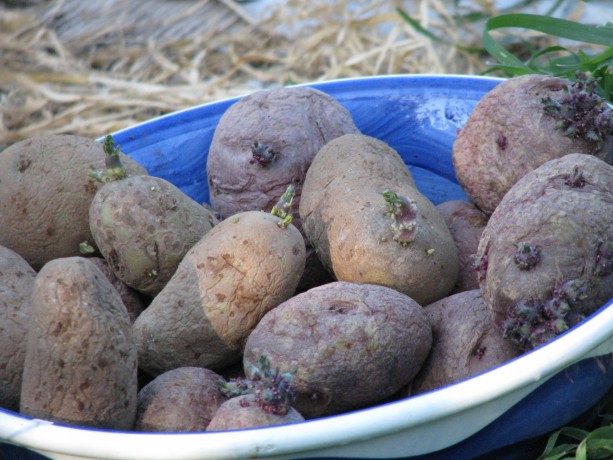
Organic chitted potatoes. ‘Seed’ potatoes aren’t potato seeds. They are small tubers that are ready to plant. Always buy organic seeds. Period. You can buy seed potatoes online or in nurserys available in Southern California just after Christmas, and sometimes in the late Fall. They usually purchase the seed from other states which have snow and don’t ship during the winter. Buying online or from organic catalogs allows you to shop among a wide variety of potatoes differing in size, color and purpose. However since we can plant potatoes in the Fall and don’t want to wait for shipping times, we can buy a bag of organic potatoes locally and sprout them ourselves. Non-organic potatoes have been treated so that they don’t sprout in the store, and are genetically modified (GMO) to last on the shelf. Sprouting potatoes is called ‘chitting’ and is very easy. Mine usually sprout in a bowl on my kitchen counter. Keep them in a light, cool area out of direct sunlight and they’ll grow. When the potatoes have chitted and ‘greened’ (have sprouts), you can either plant them whole or slice them so that each piece has at least one eye. Allow them to harden off and plant them. Give the extras to your neighbor!
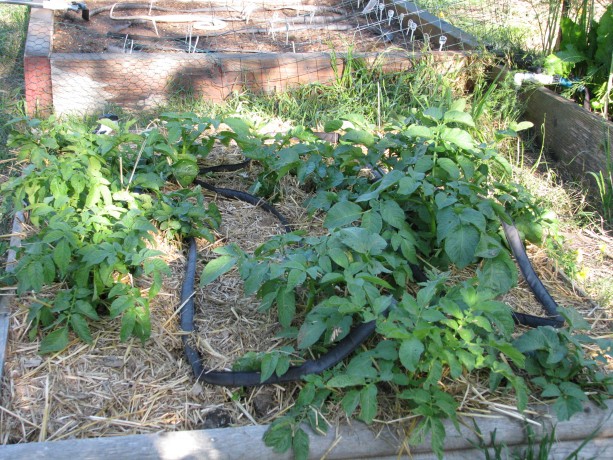
Potatoes can be grown in the ground, or in a raised bed, and then you hill up around the plant to produce more tubers. The reason for growing trashcan potatoes is that you can grow vertically, save garden space, and in particular save your back from trenching, hilling and then digging. The harvest is more productive, too, because you won’t be accidentally cutting through or spearing potatoes in the ground. Potatoes can grow this way because the tubers are actually specialized underground stems called stolons. Potatoes will produce tubers underground, but anywhere along their stems they also can grow a potato under the right conditions. Once you plant a potato ‘eye’, the eyes being the growth buds, it will send out stolons. The plant will produce potatoes below ground, and if you hill up around the stems they will also begin to swell and produce tubers.
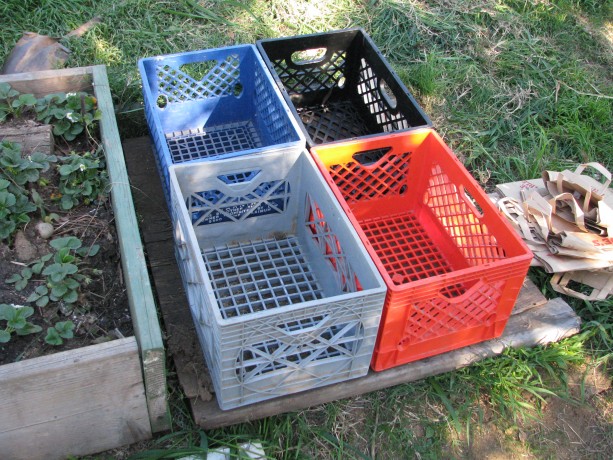
I have extra milk crates, and a source for more, so why not use them? When you plant in a trash can (with drainage holes!), as the greens shoot up you keep layering compost or straw or woodshavings or potting soil or whatever around the stems keeping a little green showing until you can’t fill the trashcan anymore.

I lined the bottoms and the outside edges with extra paper bags and watered them. When the plant is done growing the plant will bloom and sometimes even produce seeds. When the stems die back, you knock over your trashcan and harvest. Save some of the smaller ‘taters for seed for planting in the Fall.
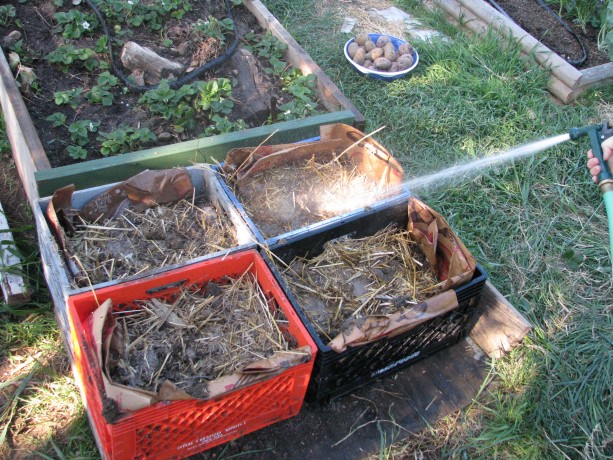
I filled the crates 2/3s full with compost mixed with chicken straw and watered well. You don’t want heavy soil or the potatoes will rot. You also want to insulate the potatoes from outside warmth. You can also root around in there earlier and pick new potatoes, or you can delay your harvest, keep water out of the trashcan and keep it in a cool spot, and harvest when you want them. The beauty of trashcan gardening is that you don’t need a trashcan. Very zen! You can drill holes in a plastic carrier, use burlap sacks, stack old tires, nursery containers, large plant pots or whatever you have. If you have a bottomless or rusted out trashcan, use it! Place it over good garden soil and allow the potatoes to grow down, too. You’ll have a little digging to harvest after you knock over your trashcan full of potatoes, but not much. To make holes in a plastic or aluminum trash can, borrow a digging bar (a long metal pry bar), place your trashcan right-side up on a dirt area, hold the bar high vertically over your trash can pointy side down and let it go. It should make a hole. Or turn the can over and use a hammer and something sharp like an awl or screwdriver (be careful you don’t shatter the top of the screwdriver! You don’t have to pound too hard. Be wise and wear safety glasses just in case). Do this multiple times to make as many holes as you can without making the bottom unstable.
Also be sure to keep the trashcan or crate potatoes in a cool place, especially if you are planting in the early spring here in Southern California. Warmth will keep the potato stems from swelling into tubers. Insulate the potatoes well and keep them cool while still allowing them enough sunlight. Fall and winter are the best times for planting potatoes here, as long as they have adequate drainage.
There is concern about leaching chemicals from plastic, or tires, or aluminum. Do the research and make yourself happy. I don’t think there is that much leaching to be worried about because the plants aren’t in there for a long time. You can always make a barrier between the soil and the sides of the containers with undyed paper or newspapers using soy ink. So save your garden space for other crops, and pop your ‘tatties in a can. Or crate. Or whatever.
Update: here is a very comprehensive article about planting potatoes. Rather than use commercial fertilizer, of course, we recommend rich compost, which will provide what your potatoes need. Also use dead garden debris such as old pea stalks (cut rather than pull them up to allow the nitrogen nodules on the roots to remain in the soil) in your planting bed or container.
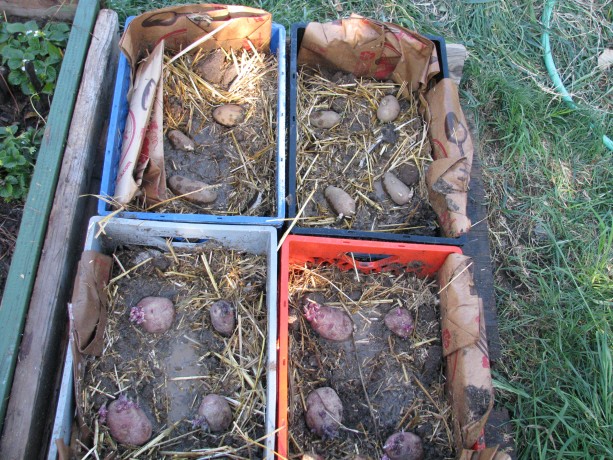
I planted whole potatoes just because I didn’t have room for lots of cut ones and these needed planting or tossing. I then covered them with about an inch of light compost and now I’m waiting! -
A Nursery Bed
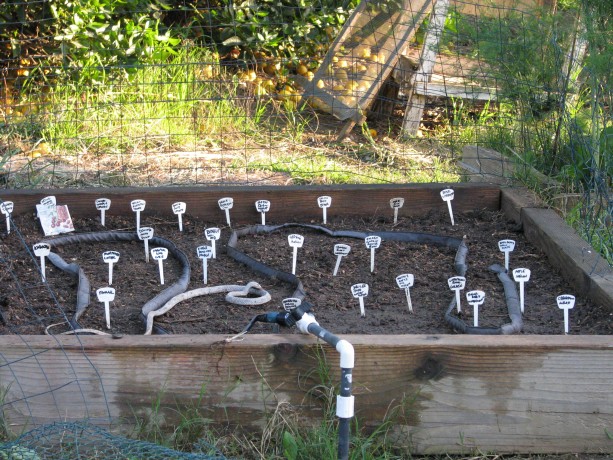
Twenty six varieties in one bed. I had a frustrating time with seeds already this season. There is a limited time when I can use my greenhouse (which doesn’t have all the frills such as fans, automated watering and window-opening) because the weather here becomes warm very quickly. I planted six flats of six six-packs each of various seeds. Many were coming up when a mouse tunneled underneath and not only ate all the larger seeds but dug into most of the rest of the cups, tossing or burying the small seed. I tried again, but the little guy found another way in. It is difficult to plant seeds around the property due to not having overhead watering, and having such a healthy insect habitat. So instead I’ve turned one of my raised beds into a nursery bed. I planted 26 types of veggies in good garden soil. They’ll come up and grow good tap roots, then be ready to transplant out to wherever I want them. Some will stay in this bed, and some will be given to friends because, after all, there are only so many tomato plants I can have.
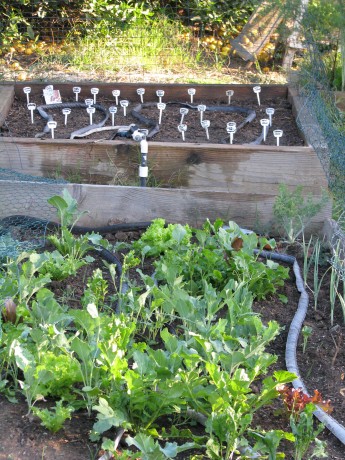
Nursery bed behind mixed greens. The bed in front of the nursery bed is the one where I scattered mixed seeds a while back, and now have a healthy crop of collards, broccoli rabe, celery, parsnips, carrots, kale, garlic, leeks, lettuce, arugula, peas and others. Mixing seeds helps confuse predators and keeps the plants healthier.
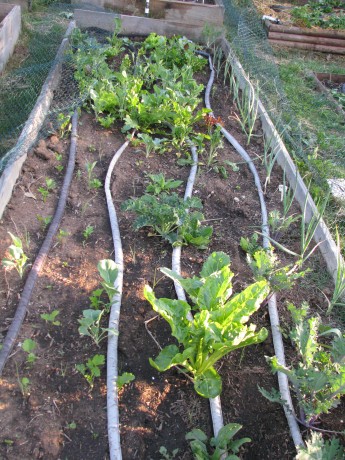
So many veg in one bed!


